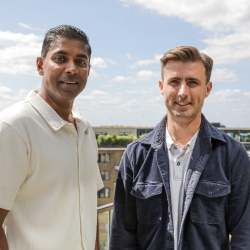Advertising operates on the fastest moving cultural plane, that of fashion and art.
Indeed, it is part of the function of an advertising agency to be closer to culture, and broader swathes thereof, than their clients. We pick up signals from any subculture gaining traction and look to ride the waves of cultural popularity, accelerating them as we do. Inevitably, this leads agencies to become extremely focused on the now, the soon, and the speculative. Thus, we encourage brands to rush in where consumers fear to tread, building experiences and stores in Second Life and NFT enabled ‘metaverse’ platforms, colonizing new media as soon as they come into existence.
At the fastest layers, culture is constantly experimenting, and many experiments don’t come to scale. We have to spend our time thinking about the future, planning campaigns for a world that doesn’t exist yet, adapting when global events like pandemics and wars flare up around us. Things do seem to change fast nowadays, don’t they?
And yet, of course, many things don’t change fast at all. Bernbach counseled us to consider humanity in evolutionary time: “It took millions of years for man’s instincts to develop. It will take millions more for them to even vary. It is fashionable to talk about changing man. A communicator must be concerned with unchanging man. With his obsessive drive to survive, to be admired, to succeed, to love, to take care of his own.”
But there are things that change, or we want to change, that operate in between the speed of Twitter and human evolution
Structures, biases and social norms change slowly. I’m far from immune to neophilia. Working in agencies as digital was just building a head of speed was exciting, there was no playbook and everything seemed up for grabs. In 2009 I worked with the London International Awards to create the NEW category. “It aimed to award ideas that leveraged the changing mediascape and emerging technology. Ideas that hacked culture, that created new engagement spaces between people and brands. Ideas from agencies that consumers were willing to pay for.”
All the new new things seemed very exciting but we have subsequently seen that any significant shift in communication technologies brings about new challenges and new externalities too. Media speeds up and spreads out, fills every crevice of the day. Constantly refreshing the feed shortens the news cycle, culture speeds up, trapped in a constant state of now.
Corporate financialization led to quarterly reporting, which led to a need to produce short-term results, which led to a general short-termism and ever shorter tenures for the average CMO. This leads to more agency turnover and a shift away from longer term relationships built on retainers towards project based engagements for agencies of all sizes. Procurement mandated pitches every few years put the agency on tilt, if they choose to re-pitch at all. This in turn has led to the ‘crisis in creativity’ named by Peter Field in his IPA report in 2019. The work being awarded no longer provides market share growth multiples it did before. Field lays the blame on short-termism, on short-term ideas, ones that spike sales and interest briefly but don’t build brands and drive accretive, profitable growth, being awarded by the juries.
Herein lies the great tension
Field and Binet’s work with the IPA dataBank show that the biggest contributions of advertising only happen over time. In The Long and the Short of It, they explain that long-term (3+ years) investment in advertising delivers double the profit of a short-term approach (less than 1 year), but a balance of both delivers even higher returns. Brands grow slowly and “short and long term effects work differently which means that short term metrics, especially direct response rates, may not be a good guide to long term success.”
Structures change slowly
When Michael Roth announced his retirement from IPG this year, it was the first head of a holding company to leave the industry in decades. Sorrell, Levy, Wren, and their cohort have been running the agency sector since the 1990s, despite a vanishingly small percentage of agency staff overall being over the age of 50. Lots of new in at the bottom, no change at the top. Agencies in the UK and USA have been announcing initiatives to increase diversity beyond middle class white men since at least the 1990s, with remarkably little impact thus far.
Structural change is slow, especially when the status quo, whom it favors, is still in charge. In 2016, only three percent of creative directors in advertising agencies were women. That has risen to about twenty-nine percent now, according to the 3percentmovement, who helped galvanise this change. It’s still not great but it’s much better. Change is fast and slow, it’s not impossible, but it’s important not to confuse the things that change fast with those that change slow.
Featured image: Akemal Abdullah / Reshot




























